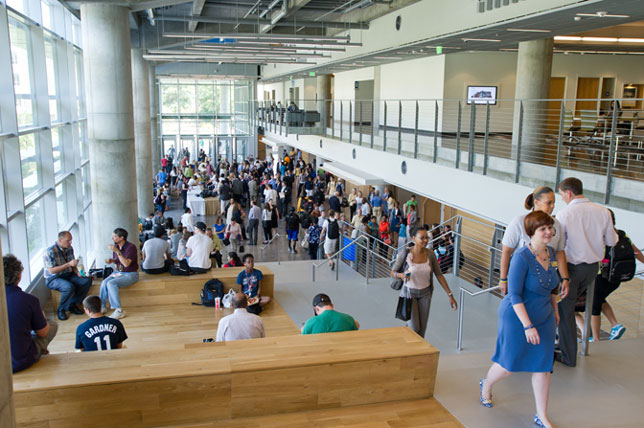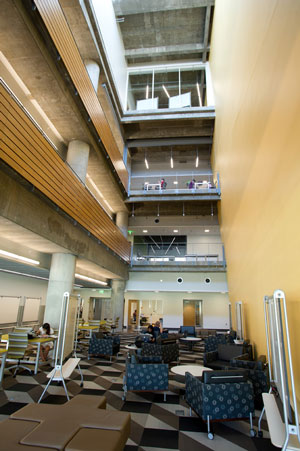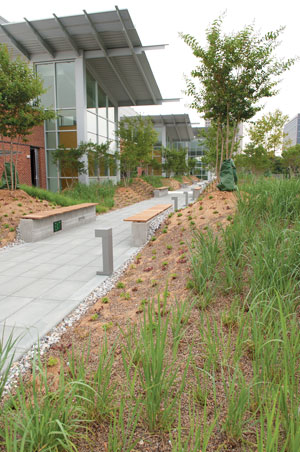Setting the Stage for Anytime, Anywhere Learning
By taking a close look at usage patterns in a new academic commons, researchers at Georgia Tech were able to fine-tune the space for students' mobile lifestyle.

Georgia Tech's Clough Commons is the academic hub for all undergraduate students on campus. (Photo courtesy of Georgia Institute of Technology)
In 2001, administrators and planners at the Georgia Institute of Technology decided they would construct a building at the center of the campus that would be the academic hub for all undergraduate students.
Then they spent the next 10 years deciding what they meant when they said they wanted the new building to be an academic hub for a generation of students born with smartphones in their hands, expecting information to be available to them via multiple paths anytime and anywhere.
The $93-million, 220,000-square-foot, five-floor Clough Commons opened in August 2011. It has dozens and dozens of classrooms that can accommodate classes as large as 330 students and as few as a handful, most equipped for distance learning as well. There are breakout study rooms, science labs and multiple academic support units, plus common areas with enough tables, chairs, sofas and marker boards to accommodate 700 students at once. Students have access to the building 24 hours a day, seven days a week. A Starbucks café is open from 7:30 a.m. to 3 a.m. every day. WiFi is ubiquitous, as are the electrical outlets necessary to keep every electronic device imaginable fully charged.

A variety of study spaces are open to students 24 hours a day, seven days a week. (Photo courtesy of Georgia Institute of Technology)
Using the Space
By most standards, the building would be considered a roaring success. For instance, Clough Commons is physically connected to the university library on two floors — and use of the library is up 15 percent since the building opened in 2011. Anecdotally, many students say Clough is their second home at Georgia Tech.
Still, university officials wanted to be sure students were using the commons the way they had intended and make adjustments if necessary. So they commissioned Herman Miller Insight and Exploration teams to study student use of Clough Commons in the fall of 2012.
Along with research observation and student interviews, Herman Miller's head education researcher, Susan Whitmer, used digital ethnography techniques to study the building use. She gave students a mobile app to record, five times a day over a designated period of time, what they were doing at Clough — and take a picture of what was going on around them.
"It's a tool to get real-time data from student experience, not just from a focus group," Whitmer said. "They are in the moment."
"A survey could have gotten some of what we wanted to know," commented Ameet Doshi, the head of Georgia Tech Library's user experience department, "but there's a degree of empathy that is introduced when you use some of these mobile ethnography techniques. This technology helped us do that."
Their research findings confirmed that most of the design decisions they had made for Clough were right: Students did use the facility in multiple ways to intensify the learning experience for themselves.
"I was able to understand that the workday of a student, from when they come in as a freshman to their last day, is really comprised of a dynamic flow of mindsets, activities and experiences that are both physical and intellectual," Whitmer said. "So it's important for us to design spaces to respond to their particular mindset in that moment. Everything for them is so fluid. We have to really understand how these spaces respond to that fluid activity."
She pointed out that "self-congestion" plays a large role in the lives of undergraduate students, and recalled one day during midterm exams when she saw a couple of students sit down at a cluster of couches, pull a marker board over and begin working their way through a math problem together. Shortly after beginning, they texted a couple more classmates, who joined their discussion a few minutes later. About 20 minutes later, a couple of students who happened to be walking by recognized their friends and joined the group — but to work on something completely different. Over the course of a couple of hours, the very informally organized group swelled and ebbed as students came and went, joined in the initial discussion about a math problem or didn't, worked together or independently.
"It's this matter of people attracting other people, even when they say they don't want to be in crowds," Whitmer said. "People do attract other people. I saw that time and time again when students were spending hours in this space."
Whitmer and Doshi were able to identify 12 different types of uses students made of Clough Commons, ranging from working "alone together" to "hacking and settling" — students feeling the need to somehow demarcate territory for themselves (perhaps by placing their personal items nearby or moving furniture around) and settle in for a long period of time; "grabbing and going" — coming to the building for a specific purpose and leaving immediately; and "meeting up" with others and "discovering" new things they didn't expect to encounter.

An immersive rooftop garden provides a "recess" space where students naturally congregate when they're ready for a break. (Photo courtesy of Georgia Institute of Technology)
Hacking and settling was the most common student use of the space, followed closely by "wait and anticipate," in which students are waiting for classes or other events to begin — a time that turns out to be quite important as they engage with one another. "It's not just a place to go to study," Doshi pointed out. "It's a place to discover new experiences, to have serendipitous encounters with art and music and each other."
That's why there is also a great deal of digital signage in the building as well as rotating art exhibits. Dance, music and theater students stage occasional impromptu "pop-up" experiences. "That creates a very dynamic atmosphere," Doshi said. "Having that is important and transcends it so that it's more than just academic. It's almost inspirational."
Room for Improvement
The researchers also discovered some pain points. The most common problem: students' perception that there weren't enough places to sit, when in fact there were plenty.
"We saw that constantly in students' snippets," Doshi said. "They'd take a picture of a study area and say they were looking for an empty table. But when you look at the pictures, there were four-person tables and only one person sitting at them."
For what he described as a "variety of psychosocial reasons," the space was underutilized when students were not always comfortable sitting next to somebody they didn't know and "hacking and settling" for long periods of time. "You see that a lot in common public places," Whitmer said. "It's led to some great possibilities for how we can experiment with design to generate a more efficient utilization."
Best Practices
Whitmer's and Doshi's best advice for any higher education institution planning an academic hub similar to Clough Commons: Get as close to the user experience as possible within the context of a specific campus. "What we found within Clough Commons may not work everywhere," Whitmer said. "Keep it in context and keep it local."
Doshi's advice was to add an element of "built-in recess," spaces where students can relax at least briefly and take a break from their studies. For instance, Clough Commons has an immersive rooftop garden where students naturally congregate when they're ready for a break. "That kind of thing will be different, depending on the situation at a campus," he said, "but it's still a way to get people to think differently, whether it's culturally or academically. It doesn't really matter as long as it works."
|
Design Recommendations
Researchers at Herman Miller and Georgia Tech have some tips for designers at other campuses thinking about creating academic hubs like Clough Commons:
- Initiate the new and different. Create spaces for unanticipated activities that can lead to new relationships, happenings and unexpected encounters with peers and faculty.
- Create anchor points that serve as hubs. Identify go-to places for students looking to meet with peers that also can act as points of reference for new users.
- Build in recess. Provide spaces where users can go without a specific reason for a release from the pressures of the collegiate experience.
- Allow for multiple proximity settings by the user. Since no two users make the same use of space, make sure they have access to the tools necessary to make it their own.
- Accommodate multiple formations of people, objects and environments. Allow for a variety of opportunities in the form of physical space, tools and artifacts to promote multiple user interactions and relationships.
- Use design cues to help users navigate and interact. Help students, in a state of constant transition, find the destinations that fit their specific needs.
- Allow improvisation when in groups. Set the stage for collaboration and community building.
- Make sure users have what they need. Eliminate the worry of not being able to locate tools and resources for learning.
|